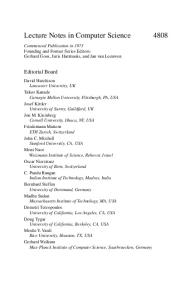Microporous Carbon-halide Nanocomposites Electrodes for Symmetric and Asymmetric Capacitor
- PDF / 1,003,397 Bytes
- 6 Pages / 612 x 792 pts (letter) Page_size
- 73 Downloads / 348 Views
1100-JJ06-04
Microporous Carbon-halide Nanocomposites Electrodes for Symmetric and Asymmetric Capacitor Prabeer Barpanda1, Giovanni Fanchini2, and Glenn G Amatucci1 1 Energy Storage Research Group, Department of Materials Science and Engineering, Rutgers University, 671, New Jersey Technology Centre, US Highway- 1, North Brunswick, NJ, 08902 2 Carbon Nanomaterials Group, Department of Materials Science and Engineering, Rutgers University, 607, Taylor Road, Busch Campus, Piscataway, NJ, 08854-8065 ABSTRACT Microporous carbon containing little mesoporosity was chemically modified through a vapor phase iodation treatment in an effort to improve the electrochemical performance of activated carbon system commonly utilized in symmetric and asymmetric capacitors. This new carbon system has been studied with respect to their structural, morphological and electrochemical properties and contrasted to the mesoporous carbon based nanocomposites. INTRODUCTION Activated carbons occupy predominant position in the field of electrochemical double layer capacitor (EDLC) due to suitable morphology (high surface area with tunable porosity) and cheap cost [1,2]. The overall charge storage in activated carbons is mainly due to the interfacial electrostatic double layer formation. However, carbon invariably delivers some intrinsic space charge formation and faradaic psuedocapacitance [2]. All these parameters can be improved by physico-chemical modification of precursor carbon. Previously, we have shown one such possible way of electrochemical improvement through the iodation of activated carbons [3-6]. Majority of these activated carbon based system is largely mesoporous in nature, which favors easy access and kinetics of large non-aqueous electrolyte ions. However, recently there has been increasing interest in usage of micropore-rich carbon to augment high-energy density. In the current work, we are studying the viability of using microporous carbon (>88% micropores) as precursor activated carbon. Homogeneous microporous carbon was produced from carbon-rich coal via chemical activation process. With chemical iodation, possible carboniodine charge transfer reaction helps forming polyiodide complex. This subsequently instigates faradaic psuedocapacitance and a possible change in the electronic properties of the precursor carbon. Microporous carbon uptakes iodine very effectively, thus giving rise to improvement in overall capacity. The iodation process and its effect on the electrochemistry of activated microporous carbons have been studied with respect to the structure and morphology of final product. These microporous carbons are contrasted to corresponding mesoporous carbon system. These microporous carbon-iodine nanocomposites systems are currently in a process of implementation has been implemented into both carbon-carbon symmetric capacitor and carbonLTO asymmetric hybrid capacitor prototypes.
EXPERIMENT Materials Synthesis Microporous carbon (IUPAC pore size: 0-2 nm) was fabricated in-house using chemical activation of anthraci
Data Loading...











